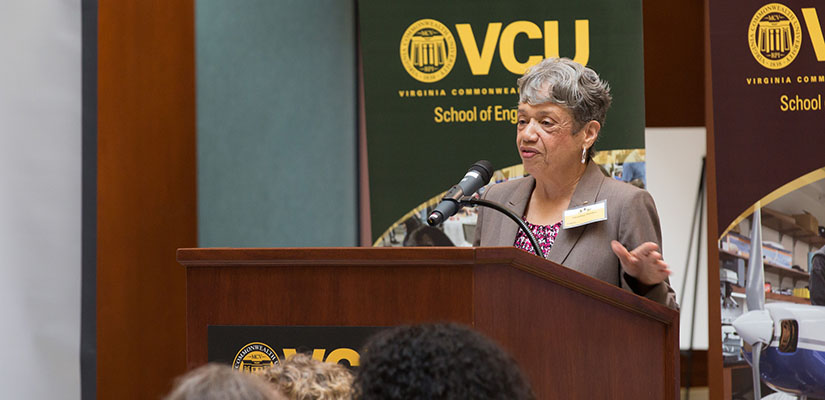Richmond, VA (March 7, 2017) – Christine Mann Darden, Ph.D., featured in the book "Hidden Figures", visited the VCU School of Engineering last month to deliver a powerful message: STEM fields — and engineering in particular — offer women unique opportunities to advance their careers and contribute to society.
Darden was the guest of honor at the school’s Celebration of Women in Engineering Luncheon, sponsored by Altria. The luncheon, now in its sixth year, was held Feb. 24 and was the culmination of the school’s celebration of Engineers Week. Approximately 110 students and faculty members were in attendance for the program, which also featured remarks by Barbara D. Boyan, Ph.D., dean of the VCU School of Engineering, and Tamika Murrell, staff engineer with Altria Client Services.
Boyan said, “We have grown up in a society where women do a lot of team building and collaboration. That’s the personality we take to the workforce.” She also pointed out that VCU’s female engineering students make up 25 percent of the student body, a figure that “puts us in the top nationwide.”
Darden used the story of her own career in aerospace to illustrate the opportunities that engineering offers women. After earning a B.S. in mathematics from Hampton Institute (now Hampton College) and an M.S. from Virginia State University, she joined NASA in 1967. There, she got to know the real-life mathematicians Katherine G. Johnson, Dorothy Vaughan and Mary Jackson portrayed in the film. As one of NASA’s “human computers,” Darden wrote complex equations to support engineers at NASA’s Langley Research Center.
“We did the calculations to determine whether the metals on the shielding could take the forces and to ensure that the craft would come back into the atmosphere at the right angle,” she said. Two years after Darden’s arrival at NASA, she saw the computing office’s work pay off spectacularly with the 1969 Apollo moon landing.
She also saw that NASA’s largely-female computing office offered few paths for career advancement, while opportunities for growth flourished in its predominantly-male engineering divisions. Many of the engineers had math degrees, just as Darden did, so she decided to explore the field. “As soon as I took Engineering 101, I found out that I would rather know what those equations stood for,” she said.
Darden requested, and eventually received, a transfer to the engineering department. In 1983, she earned a doctorate in engineering from George Washington University. She became one of the world’s leading experts in sonic boom technology, authoring 57 technical papers and articles on sonic boom prediction and minimization. She advanced through senior-level positions with NASA, receiving numerous honors including two NASA medals.
Darden said it was the choice to pursue engineering that most significantly shaped her 40-year NASA career. To the many young women in the audience who have made that choice already, she said, “I congratulate each of you on your success in what you are doing.”
Murrell followed Darden, a position that she compared to “having to follow Beyoncé at the talent show.” Murrell, an alumna of VCU’s electrical engineering program, said that opportunities for women in engineering continue to multiply as companies see the value women add to the field as holistic problem-solvers and skillful collaborators.
“Today has been rewarding. A path for you has been forged by the previous generations of women in engineering,” Murrell said. “Stick with it — and when something isn’t given to you, figure out a workaround.”
